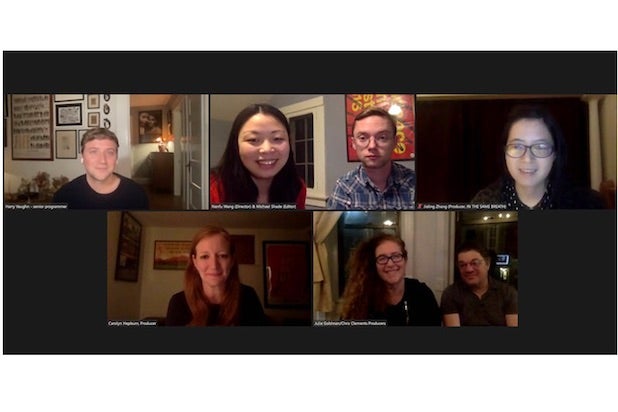
Sundance Q&A for ‘In the Same Breath’/ Thanks To Sundance Institute
The COVID-19 pandemic has had a big impact on the 2021 Sundance Movie Celebration, which was required to take place largely online, with spread outside screenings and socially-distanced occasions in cities around the country. However the pandemic has also impacted Sundance creatively, resulting in an opening 4 days in which filmmakers have used a range of techniques and genres to face the problems of a virus that was just beginning to surface when the last in-person Sundance happened in Park City a year ago.
The most obvious example is the opening-night documentary “In the Same Breath” from Chinese-born director Nanfu Wang, who came to Park City straight from China in January 2020, and after that discovered she couldn’t rejoin her husband and son there because of the pandemic lockdown. Her film includes wrenching video footage from Wuhan in the early days of the virus however broadens to look at the Chinese and American governments’ mishandling of the pandemic for political factors.
However a documentary about COVID is far from the only Sundance movie to bear the marks of it.
Likewise Check Out: Sundance 2021: What Has Sold So Far, From ‘CODA’ to ‘Leave’ (Photos)
Other Sundance movies that have absolutely nothing to do with infections have somehow captured the state of mind of the minute. Lucy Walker’s “Bring Your Own Brigade,” for instance, is a documentary about the wildfires that have grown progressively lethal in California over the past few years. As she dove into the story, Walker said when she came into TheWrap’s virtual Sundance studio that she found the science rejection and political motivations behind the COVID response was also present in our reaction to wildfires.
On The Other Hand, Robin Wright’s directorial debut, “Land,” is in some ways a meditation on isolation; the weird drama “John and the Hole” discovers a household in its own enforced seclusion, which costar Jennifer Ehle compared to pandemic stay-at-home orders; and Christopher Abbott’s efficiency in Jerrod Carmichael’s “On the Count of 3” is an encapsulation of latest thing that hides under the surface area (and typically above the surface) in 2021.
Other Sundance films, even ones embeded in different times, have ended up speaking with the unpredictable and tumultuous time in which we live. “When I began, I thought I was making a motion picture about 1969,” director Questlove told TheWrap, describing his documentary “Summertime of Soul,” which narrates a Harlem music celebration however broadens to cover concerns of racial stress. “But then I realized it was as much about today as it was about 50 years earlier.”
Also Check Out: ‘ Land’ Film Review: Robin Wright Relies on Nature for Her Suppressed Directorial Launching
Sundance 2021 has actually certainly been about today, beginning with the fact that individuals are watching it from their homes and all the Q&A s are virtual. It’s likewise about today due to the fact that the films deal with race (Rebecca Hall’s “Passing,” Shaka King’s upcoming “Judas and the Black Messiah”), refugees (the animated documentary “Get away,” the ISIS doc “Sabaya”), phony news (” Misha and the Wolves”), LGBT problems (” My Call Is Pauli Murray”) and revolutions coming from the oddest locations (nuns in “Rebel Hearts,” kids’s television in “Street Gang: How We Got to Sesame Street”).
Even the celebration’s most significant sale ever, “CODA,” takes a fairly traditional, crowd-pleasing coming-of-age story and provides it a spin that talks to today’s cries for addition and variety by casting three deaf stars in vital functions. And as Sharon Waxman explained, behind the scenes the festival has actually hit brand-new peaks in showcasing work from female directors.
That does not indicate that Sundance ’21 has actually been all about existing concerns; it’s likewise showcased a common range of character research studies (the docs “Ailey” and “Rita Moreno: Simply a Girl Who Chose to Go for It”), hard dramas (” Mass”) and indie riffs (” R #J,” which attempts very hard to update Shakespeare for the social media age).
Also Check Out: ‘ Passing’ Film Review: Rebecca Hall’s Sensational Directorial Debut Provocatively Checks Out Race
Typically, four days into a Sundance Film Festival would be time to recall at the celebration up until now and look ahead to the remaining week– but in this case, almost everything has currently been showcased. Not just was the celebration decreased from its usual 11- day diminish to 7 days, however it was also severely frontloaded: Of the 74 includes screening over 6 days (the seventh being committed to award winners), 67 will have premiered by the end of Sunday.
What’s left are some movies that have already played elsewhere (” Night of the Kings,” “The World to Come”) and Warner Bros.’ premiere of “Judas and the Black Messiah,” to name a few. Which indicates that Sundance up until now is basically all the Sundance we’re gon na get– a slimmed-down, virtualized, COVID-ized festival that has set a new record for the most significant deal ever while having a hard time to catch the Park City sensation when no one’s in Park City.
The Sundance virtual festival platform is advanced when it comes to moving the celebration experience online– however like everything else about the previous year, it’s not actually what we desired.
In a pandemic year, we’ll simply have to settle for a pandemic Sundance.

No comments:
Post a Comment